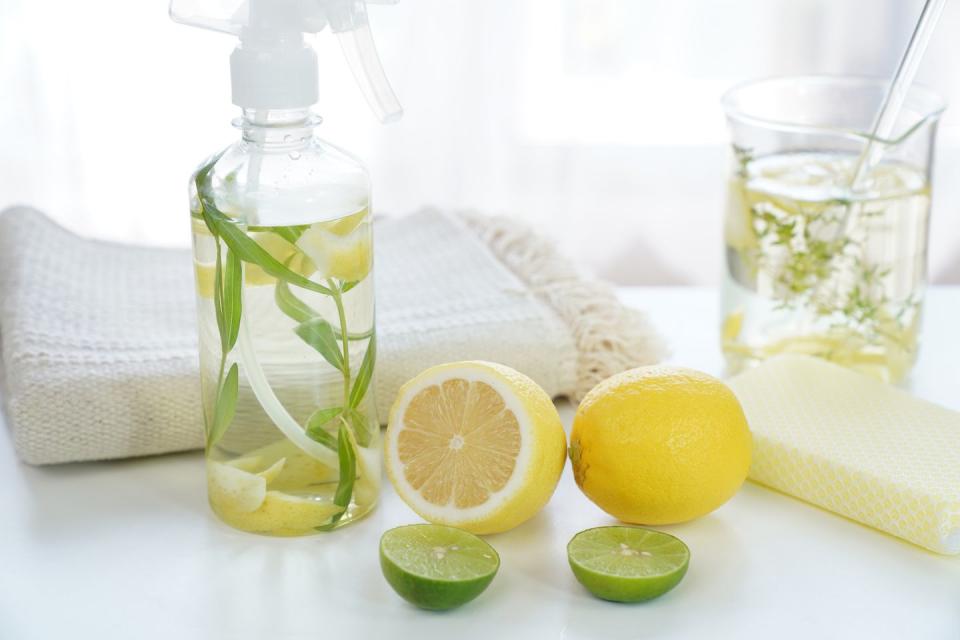How to clean limescale

With 60% of the UK living in a hard or very hard water area, limescale is a big problem for many households. But if you feel like the chalky deposits are getting everywhere, from your shower screen to the kitchen sink, we've got the tricks for keeping it at bay. Just read our expert advice...
Lemon juice and vinegar
The good news is that getting rid of limescale doesn't require expensive cleaning products! Lemon juice and vinegar can help you tackle most of your limescale problems — a win for your pocket and for the environment.
Lemon juice and vinegar are both acidic, meaning that they can break down the calcium carbonate that limescale is made from. Here's how you can use these green cleaners to your advantage.
It’s worth noting that we’re talking about distilled white vinegar here, not malt vinegar. While malt vinegar contains the same useful acidic properties, its colour could potentially stain surfaces on contact and its heavy scent can really linger in the home.

Bathroom
Make up a spray bottle of half white vinegar and half water, and use it regularly as you would a general bathroom cleaning spray on tiles, basins, baths, showers and taps to keep limescale at bay. Always rinse thoroughly with plain water afterwards.
If limescale has already built up, soak a tea towel or cloth in the vinegar solution and wrap it around the tap, then leave for a couple of hours or overnight. You may need to gently work away any remaining residue with an old toothbrush. As an alternative for taps, or if you don’t like that vinegary smell, halve a lemon, squeeze out some juice, and put the half lemons on to the tap spouts. Then soak a cloth in the lemon juice and wrap around the rest of the tap. Always rinse well with plain water once cleaned.
GHI TIP: Don’t use either of these methods on plated taps, particularly gold plated. The acid in vinegar and lemon juice can damage their finish.
Shower heads
Remove the shower head and soak overnight in a solution of half water and half white vinegar. Rinse with plain water after soaking and use a needle to poke any remaining limescale out of the jet holes.

Toilets
For ceramic toilets, try removing heavy limescale deposits by scrubbing gently with an old toothbrush soaked in white vinegar, or for very hard and encrusted limescale, don the rubber gloves and use an old pumice stone to gently rub away the limescale below the water level.
Kitchen sink and taps
Your kitchen sink and taps can be treated for limescale in the same way as the bathroom sink and taps.
Kettles and coffee machines
Fill the kettle to just below half full with water, then bring it part-way to boil, switching it off just before it starts to bubble. Unplug it, then carefully add white distilled vinegar to the water, filling it to about ¾ full. Leave a note by the kettle so no one accidentally uses it, then let it sit for several hours (ideally overnight) to work its magic. Tip the mixture away once time’s up, then rinse and boil a fresh batch of water for a final cleanse.
You can use less water and vinegar if the limescale is less abundant in your kettle. You also don’t have to heat the water beforehand for light limescale removal.
If your coffee maker can be descaled using vinegar (check the user manual), add the vinegar solution to the water compartment and follow the manufacturer's descaling instructions. Empty, fill with plain water and run a coffee brewing cycle to flush the system through.
GHI Tip: Some brands of coffee machines have their own branded descalers, so check the instructions first. If you don't use the branded product, you could invalidate the warranty.

Dishwashers
For the dishwasher, fill a bowl with 500ml of vinegar and sit it upright in the top basket, before running a standard wash on empty (no detergent). As well as removing the limescale, it'll help freshen up your appliance!
Do not clean the seal around the dishwasher, or washing machine, with vinegar; it will degrade it on contact. Instead, use a suitable cleaner. Rubber is one of the 7 places you should never clean with vinegar.
Washing machines
For your washing machine, use a large cup of white vinegar or lemon juice in place of your usual detergent and run the machine empty on a normal wash cycle.
Irons
First and foremost check the manual. Most irons have built in ‘anti-calc’ or cleaning functions, so it’s always best to follow the manufacturer's guidance so you don’t invalidate the warranty.
Failing that, fill the water tank to around a third full with half white vinegar and half water, switch it on to a steam setting and iron an old towel until the tank is empty and all the vinegar and water has worked its way through. Repeat with fresh water to rinse the system out and get rid of any traces of vinegar.
You Might Also Like


